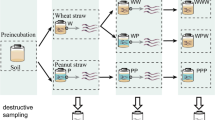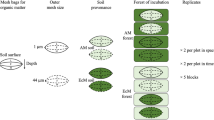Abstract
Soil-dwelling mites of four plots under organic management were investigated in April and December 1998 and in December 1999. Their populations were compared with mite populations in a pasture and forest in the vicinity. It was observed that there was always an initial reduction in the populations of soil mites and in the activity of the epigeic forms whenever a plot was opened up and disturbed mechanically in preparation for cultivation, irrespective of previous organic inputs. With time, the densities and activities of mites recovered under organic management. The uropodine and oribatid mites in particular benefited more from organic management than gamasine and actinedid mites. Uropodine mites increased tremendously under banana where there was fresh cow dung manure. Oribatid mite species Nothrus seropedicalensis and Archegozetes magnus were dominant in organic plots where the soil was moist and temperatures were lower than the ambient. Protoribates rioensis was dominant in organic plots where the soil was drier and temperatures were higher than the ambient. Galumna was the most active oribatid taxon on the floor of all plots, with the highest activity recorded under maracuja and in pasture plots. The results suggest that while densities and activities of soil mites increased in the organic plots, the community structure and recruitment period of oribatid mites were altered. Oribatid mite diversity was higher in the organic plots than in the pasture but lower than in the forest, where Belba sp. and many Eremobelboid brachypiline genera were present, but absent in the organic plots and pasture.
Similar content being viewed by others
References
J. Adis (1979) ArticleTitleProblems of interpreting arthropod sampling with pitfall traps Zoologiescher Anzeiger 202 IssueID3/4 177–184
F.E. Allison (1973) Developments in Science 3: soil organic matter and its role in crop production Elsevier Scientific Publications Company New York 637
D.L. de Almeida (1998) Sistema integrado de producao agroecologica – “Fazendinha Agroecologica Km 47” J.L. de Souza C.A.S. do Carmo (Eds) Encontro Nacional Sobre Producao Organica de Hortalicas, 1., abr. 1998 Vitoria. Palestras e Trabalhos Tecnicos Vitoria EMCAPA 77–94
M.A. Altieri C.A. Francis (1992) ArticleTitleIncorporating agroecology into the conventional agricultural curriculum American Journal of Alternative Agriculture 7 89–93
M.A. Badejo (1987) ArticleTitleSoil microarthropod fauna of three contrasting habitats in the Obafemi Awolowo University Campus, Ile-IfeNigeria Ife J. Sci. 2 7–14
M.A. Badejo (1990) ArticleTitleSeasonal abundance of soil mites (Acarina) in two contrasting environments Biotropica 22 382–390
M.A. Badejo (1994) ArticleTitleEffect of accidental fire on soil mite density in a forest reserve in Nigeria Exp. Appl. Acarol. 18 703–710
M.A. Badejo (1995) ArticleTitleAcarine populations of forest and fallow plots in Ile-IfeNigeria Pedobiologia 39 555–560
M.A. Badejo B.A. Lasebikan (1988) ArticleTitleComparative studies of the acarine populations of a secondary regrowth forest and a cassava plantation in Ile-IfeNigeria Pedobiologia 32 111–116
M.A. Badejo O.A. Akinyemiju (1989) ArticleTitleInfluence of atrazine on soil microarthropod fauna and the performance of maize (Zea mays L.) in a humid tropical environment Ife J. Agric. 11 41–50
M.A. Badejo J.I. Olaifa (1997) ArticleTitleEffects of precultivation and weed control practices on the activity of epigeic collembola fauna of cowpea Insect Sci. Appl. 17 192–198
M.A. Badejo J.A.A. Espindola J.G.M. Guerra Prefixde A.M. Aquino M.E.F. Correa (2002a) ArticleTitleSoil oribatid mites under three species of legumes in an ultisol in Brazil Exp. Appl. Acarol. 27 283–296
M.A. Badejo S. Woas L. Beck (2002b) ArticleTitleDescription of six species of nothroid mites from Nigeria and Brazil (Acari: Oribatida: Nothroidea) Genus 13 IssueID4 505–548
M.A. Badejo S. Woas L. Beck (2002c) ArticleTitleRedescription of Archegozetes magnus (Sellinick, 1925) (Acari: Oribatida: Trhypochthonioidea) from Brazil and description of two new species of nanhermanniid mites: Bicyrthermannia nigeriana (Acari: Oribatida: Nanhermannioidea) and Masthermannia seropedica (Acari: Oribatida: Nanhermannioidea) Genus 14 IssueID1 125–149
M.A. Badejo S. Woas L. Beck (2002d) ArticleTitleNew pterogasterine mites from Nigeria and Brazil I. Scheloribates, MulierculaPeloribates System. Appl. Acarol. Sp. Publ. 12 1–60
M.A. Badejo S. Woas L. Beck (2003) ArticleTitleNew pterogasterine mites from Nigeria and Brazil II. Protoribates Acaralogia XLIII 1 121–132
Balogh J. and Balogh P. 1992. The Oribatid Genera of the World, Vol. 1. The Hungarian National Museum Press, 263 pp.
V.K. Bloomfield C.A.A. Santana L.M. Carvalho N.S.G. Dávila R.T. Oliveira L.M.S. Magalhães (1997) Estrutura de um fragmento de floresta secundária de encosta em Seropédica-RJ. III Simpósio Nacional de Recuperação de Áreas Degradadas Ouro PretoBrasil
J.W. Butcher R. Snider J.R. Snider (1971) ArticleTitleBioecology of edaphic Collembola and Acarina Ann. Rev. Entomol. 16 249–288
P. Gjelstrup (1979) ArticleTitleEpiphytic cryptostigmatid mites on some beech- and birch-trees in Denmark Pedobiologia 19 1–8
M.F. Grandjean (1954) ArticleTitleEssai de classification des Oribates (Acariens) Bulletin de la Société Zoologique de France 78 421–446
Guerra J.G.M. De-Polli H. and de Almedia D.L. Managing carbon and nitrogen in tropical organic farming through green manuring. In: Badejo M.A. and Togun A.O. (eds), Strategies amd Tactics of Sustainable Agriculture in the Tropics (STASAT), Vol. 2. College Press, Ibadanand Enproct Consultants, Lagos, Nigeria (in press).
G. Harding (1960) ArticleTitleThe competitive exclusion principle Science 131 1292–1297
P.F. Hendrix D.A. Crossley J.M. Blair D.C. Coleman et al. (1990) Soil biota as components of sustainable agro-ecosystems C.A., Edwards (Eds) Sustainable Agricultural Systems Soil and Water Conservation Society Ankeny, IA 637–654
V. Huhta E. Karpinen M. Nurminen S.A. Valpa (1967) ArticleTitleEffect of silvicultural practices upon arthropodannelid and nematode populations in coniferous soil Ann. Zool. Fenn. 4 87–143
J. Kethley (1990) Acarina: Prostigmata (Actinedida) D.L. Dindal (Eds) Soil Biology Guide John Wiley and Sons New York 667–756
G.W. Krantz B.D. Ainscough (1990) Acarina: Mesostigmata (Gamasida) D.L. Dindal (Eds) Soil Biology Guide John Wiley and Sons New York 583–665
B.A. Lasebikan (1974) ArticleTitleA preliminary communication on microarthropods from a tropical rainforest in Nigeria Pedobiologia 14 402–411
N. Lampkin (1994) Organic Farming Farming Press Ipswich 715
P. Lavelle D. Bignell M. Lepage V. Wolters P. Roger P. Ineson O.W. Heal S. Dhillion (1997) ArticleTitleSoil function in a changing world: the role of invertebrate ecosystem engineers Eur. J. Soil Biol. 33 159–193
M.J. Mitchell (1977) ArticleTitlePopulation dynamics of oribatid mites. Acari: Cryptostigmata in an open woodland soil Pedobiologia 17 303–319
J.C. Moore R.J. Snider L.S. Robertson (1984) ArticleTitleEffects of different management practices on Collembola and Acarina in corn production systems. I. The effects of no-tillage and Atrazine Pedobiologia 26 143–152
V. Nicolai (1989) ArticleTitleThermal properties and soil fauna on the bark of trees in two different African ecosystems Oecologia 80 421–430
R.A. Norton (1990) Oribatida D.L. Dindal (Eds) Soil Biology Guide John Wiley and Sons New York 779–804
O. Oludimu (1998) Biodynamic farming: a farmer-centered approach to increasing productivity M.A. Badejo A.O. Togun (Eds) Strategies and Tactics of Sustainable Agriculture in the Tropics (STASAT) College Press, Ibadan and Enproct Consultants Lagos, Nigeria 222–231
S. Palmer R.A. Norton (1991) ArticleTitleTaxonomic, geographic and seasonal distribution of thelytokous parthenogenesis in the Desmonomata (Acari: Oribatida) Exp. Appl. Acarol. 12 67–81
A. Prinzing H.P. Wirtz (1997) The epiphytic lichen, Evernia prunastri L., as a habitat for arthropods: shelter from desiccation, food-limitation and indirect mutualism N.E. Stork R.K. Didham (Eds) Canopy Arthropods Chapman & Hall London 427–494
SAS 1985. SAS User’s Guide: Statistics, 1985 edn. Statistical Analysis Systems InstituteCary, NC.
H. Siepel E.M. Ruiter-Dijkman (1992) ArticleTitleFeeding guilds of oribatid mites based on their cabohydrase activities Soil Biol. Biochem. 26 1491–1497
T.R.E. Southwood (1978) Ecological Methods, EditionNumber2 Chapman and Hall New York 524
USDASoil Survey Staff 1975. Soil Taxonomy: A Basic System of Soil Classification for Making and Interpreting Soil Surveys. Handbook No. 436. United States Government Printing OfficeWashington, DC, USA.
M.B. Usher (1975) ArticleTitleSeasonal and vertical distribution of a population of soil arthropods: Cryptostigmata Pedobiologia 15 364–374
E. Van derWerf (1998) Sustainable agriculture in south-east Ghana: a case study of the Agomeda Agricultural Project Badejo Togun (Eds) Strategies and Tactics of Sustainable Agriculture in the Tropics (STASAT) College Press, Ibadan and Enproct Consultants Lagos, Nigeria 170–195
J.A. Wallwork (1976) The Distribution and Diversity of Soil Fauna Academic Press London 355
Author information
Authors and Affiliations
Corresponding author
Rights and permissions
About this article
Cite this article
Badejo, M. ., De Aquino, A. ., De-Polli, H. et al. Response of soil mites to organic cultivation in an ultisol in southeast Brazil. Exp Appl Acarol 34, 345–364 (2004). https://doi.org/10.1007/s10493-004-0201-y
Accepted:
Issue Date:
DOI: https://doi.org/10.1007/s10493-004-0201-y




